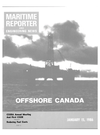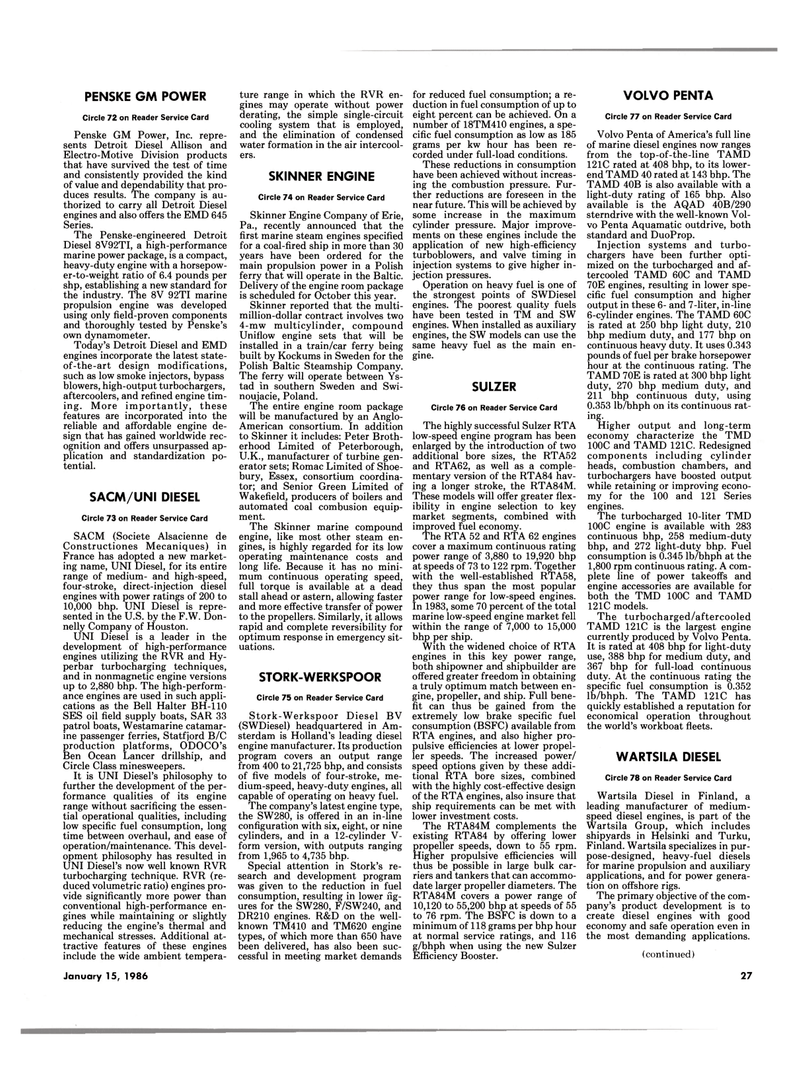
Page 25: of Maritime Reporter Magazine (January 15, 1986)
Read this page in Pdf, Flash or Html5 edition of January 15, 1986 Maritime Reporter Magazine
PENSKE GM POWER
Circle 72 on Reader Service Card
Penske GM Power, Inc. repre- sents Detroit Diesel Allison and
Electro-Motive Division products that have survived the test of time and consistently provided the kind of value and dependability that pro- duces results. The company is au- thorized to carry all Detroit Diesel engines and also offers the EMD 645
Series.
The Penske-engineered Detroit
Diesel 8V92TI, a high-performance marine power package, is a compact, heavy-duty engine with a horsepow- er-to-weight ratio of 6.4 pounds per shp, establishing a new standard for the industry. The 8V 92TI marine propulsion engine was developed using only field-proven components and thoroughly tested by Penske's own dynamometer.
Today's Detroit Diesel and EMD engines incorporate the latest state- of-the-art design modifications, such as low smoke injectors, bypass blowers, high-output turbochargers, aftercoolers, and refined engine tim- ing. More importantly, these features are incorporated into the reliable and affordable engine de- sign that has gained worldwide rec- ognition and offers unsurpassed ap- plication and standardization po- tential.
SACM/UNI DIESEL
Circle 73 on Reader Service Card
SACM (Societe Alsacienne de
Constructiones Mecaniques) in
France has adopted a new market- ing name, UNI Diesel, for its entire range of medium- and high-speed, four-stroke, direct-injection diesel engines with power ratings of 200 to 10,000 bhp. UNI Diesel is repre- sented in the U.S. by the F.W. Don- nelly Company of Houston.
UNI Diesel is a leader in the development of high-performance engines utilizing the RVR and Hy- perbar turbocharging techniques, and in nonmagnetic engine versions up to 2,880 bhp. The high-perform- ance engines are used in such appli- cations as the Bell Halter BH-110
SES oil field supply boats, SAR 33 patrol boats, Westamarine catamar- ine passenger ferries, Statfjord B/C production platforms, ODOCO's
Ben Ocean Lancer drillship, and
Circle Class minesweepers.
It is UNI Diesel's philosophy to further the development of the per- formance qualities of its engine range without sacrificing the essen- tial operational qualities, including low specific fuel consumption, long time between overhaul, and ease of operation/maintenance. This devel- opment philosophy has resulted in
UNI Diesel's now well known RVR turbocharging technique. RVR (re- duced volumetric ratio) engines pro- vide significantly more power than conventional high-performance en- gines while maintaining or slightly reducing the engine's thermal and mechanical stresses. Additional at- tractive features of these engines include the wide ambient tempera-
January 15, 1986 ture range in which the RVR en- gines may operate without power derating, the simple single-circuit cooling system that is employed, and the elimination of condensed water formation in the air intercool- ers.
SKINNER ENGINE
Circle 74 on Reader Service Card
Skinner Engine Company of Erie,
Pa., recently announced that the first marine steam engines specified for a coal-fired ship in more than 30 years have been ordered for the main propulsion power in a Polish ferry that will operate in the Baltic.
Delivery of the engine room package is scheduled for October this year.
Skinner reported that the multi- million-dollar contract involves two 4-mw multicylinder, compound
Uniflow engine sets that will be installed in a train/car ferry being built by Kockums in Sweden for the
Polish Baltic Steamship Company.
The ferry will operate between Ys- tad in southern Sweden and Swi- noujacie, Poland.
The entire engine room package will be manufactured by an Anglo-
American consortium. In addition to Skinner it includes: Peter Broth- erhood Limited of Peterborough,
U.K., manufacturer of turbine gen- erator sets; Romac Limited of Shoe- bury, Essex, consortium coordina- tor; and Senior Green Limited of
Wakefield, producers of boilers and automated coal combusion equip- ment.
The Skinner marine compound engine, like most other steam en- gines, is highly regarded for its low operating maintenance costs and long life. Because it has no mini- mum continuous operating speed, full torque is available at a dead stall ahead or astern, allowing faster and more effective transfer of power to the propellers. Similarly, it allows rapid and complete reversibility for optimum response in emergency sit- uations.
STORK-WERKSPOOR
Circle 75 on Reader Service Card
Stork-Werkspoor Diesel BV (SWDiesel) headquartered in Am- sterdam is Holland's leading diesel engine manufacturer. Its production program covers an output range from 400 to 21,725 bhp, and consists of five models of four-stroke, me- dium-speed, heavy-duty engines, all capable of operating on heavy fuel.
The company's latest engine type, the SW280, is offered in an in-line configuration with six, eight, or nine cylinders, and in a 12-cylinder V- form version, with outputs ranging from 1,965 to 4,735 bhp.
Special attention in Stork's re- search and development program was given to the reduction in fuel consumption, resulting in lower fig- ures for the SW280, F/SW240, and
DR210 engines. R&D on the well- known TM410 and TM620 engine types, of which more than 650 have been delivered, has also been suc- cessful in meeting market demands for reduced fuel consumption; a re- duction in fuel consumption of up to eight percent can be achieved. On a number of 18TM410 engines, a spe- cific fuel consumption as low as 185 grams per kw hour has been re- corded under full-load conditions.
These reductions in consumption have been achieved without increas- ing the combustion pressure. Fur- ther reductions are foreseen in the near future. This will be achieved by some increase in the maximum cylinder pressure. Major improve- ments on these engines include the application of new high-efficiency turboblowers, and valve timing in injection systems to give higher in- jection pressures.
Operation on heavy fuel is one of the strongest points of SWDiesel engines. The poorest quality fuels have been tested in TM and SW engines. When installed as auxiliary engines, the SW models can use the same heavy fuel as the main en- gine.
SULZER
Circle 76 on Reader Service Card
The highly successful Sulzer RTA low-speed engine program has been enlarged by the introduction of two additional bore sizes, the RTA52 and RTA62, as well as a comple- mentary version of the RTA84 hav- ing a longer stroke, the RTA84M.
These models will offer greater flex- ibility in engine selection to key market segments, combined with improved fuel economy.
The RTA 52 and RTA 62 engines cover a maximum continuous rating power range of 3,880 to 19,920 bhp at speeds of 73 to 122 rpm. Together with the well-established RTA58, they thus span the most popular power range for low-speed engines.
In 1983, some 70 percent of the total marine low-speed engine market fell within the range of 7,000 to 15,000 bhp per ship.
With the widened choice of RTA engines in this key power range, both shipowner and shipbuilder are offered greater freedom in obtaining a truly optimum match between en- gine, propeller, and ship. Full bene- fit can thus be gained from the extremely low brake specific fuel consumption (BSFC) available from
RTA engines, and also higher pro- pulsive efficiencies at lower propel- ler speeds. The increased power/ speed options given by these addi- tional RTA bore sizes, combined with the highly cost-effective design of the RTA engines, also insure that ship requirements can be met with lower investment costs.
The RTA84M complements the existing RTA84 by offering lower propeller speeds, down to 55 rpm.
Higher propulsive efficiencies will thus be possible in large bulk car- riers and tankers that can accommo- date larger propeller diameters. The
RTA84M covers a power range of 10,120 to 55,200 bhp at speeds of 55 to 76 rpm. The BSFC is down to a minimum of 118 grams per bhp hour at normal service ratings, and 116 g/bhph when using the new Sulzer
Efficiency Booster.
VOLVO PENTA
Circle 77 on Reader Service Card
Volvo Penta of America's full line of marine diesel engines now ranges from the top-of-the-line TAMD 121C rated at 408 bhp, to its lower- end TAMD 40 rated at 143 bhp. The
TAMD 40B is also available with a light-duty rating of 165 bhp. Also available is the AQAD 40B/290 sterndrive with the well-known Vol- vo Penta Aquamatic outdrive, both standard and DuoProp.
Injection systems and turbo- chargers have been further opti- mized on the turbocharged and af- tercooled TAMD 60C and TAMD 70E engines, resulting in lower spe- cific fuel consumption and higher output in these 6- and 7-liter, in-line 6-cylinder engines. The TAMD 60C is rated at 250 bhp light duty, 210 bhp medium duty, and 177 bhp on continuous heavy duty. It uses 0.343 pounds of fuel per brake horsepower hour at the continuous rating. The
TAMD 70E is rated at 300 bhp light duty, 270 bhp medium duty, and 211 bhp continuous duty, using 0.353 lb/bhph on its continuous rat- ing.
Higher output and long-term economy characterize the TMD 100C and TAMD 121C. Redesigned components including cylinder heads, combustion chambers, and turbochargers have boosted output while retaining or improving econo- my for the 100 and 121 Series engines.
The turbocharged 10-liter TMD 100C engine is available with 283 continuous bhp, 258 medium-duty bhp, and 272 light-duty bhp. Fuel consumption is 0.345 lb/bhph at the 1,800 rpm continuous rating. A com- plete line of power takeoffs and engine accessories are available for both the TMD 100C and TAMD 121C models.
The turbocharged/aftercooled
TAMD 121C is the largest engine currently produced by Volvo Penta.
It is rated at 408 bhp for light-duty use, 388 bhp for medium duty, and 367 bhp for full-load continuous duty. At the continuous rating the specific fuel consumption is 0.352 lb/bhph. The TAMD 121C has quickly established a reputation for economical operation throughout the world's workboat fleets.
WARTSILA DIESEL
Circle 78 on Reader Service Card
Wartsila Diesel in Finland, a leading manufacturer of medium- speed diesel engines, is part of the
Wartsila Group, which includes shipyards in Helsinki and Turku,
Finland. Wartsila specializes in pur- pose-designed, heavy-fuel diesels for marine propulsion and auxiliary applications, and for power genera- tion on offshore rigs.
The primary objective of the com- pany's product development is to create diesel engines with good economy and safe operation even in the most demanding applications. (continued) 27

 24
24

 26
26
